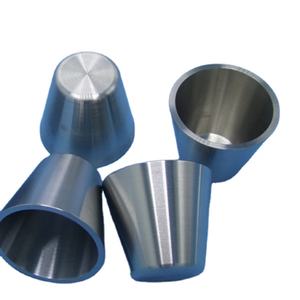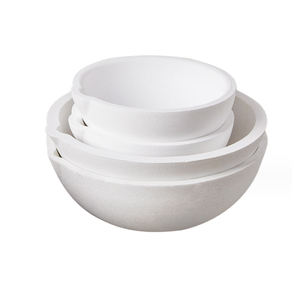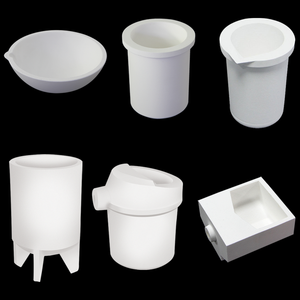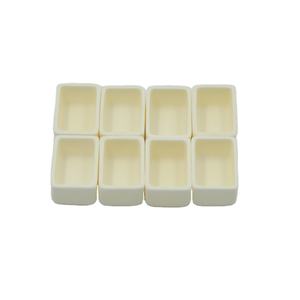Professional industry ceramic supplier, silicon nitride, silicon carbide, aluminum nitride and any other kinds of ceramics.
PRODUCT PARAMETERS
Description
Overview of Standard 99.5 Alumina Refractory Melting Ceramic Crucible
Standard 99.5 Alumina Refractory Melting Ceramic Crucible are specialized containers designed for withstanding extremely high temperatures in laboratory and industrial settings. They are essential for processes such as melting, calcining, and heat-treating a wide variety of materials, including metals, glasses, and chemicals. Our crucibles are engineered for superior thermal stability and chemical resistance, ensuring purity and reliability in the most demanding applications.
Features of Standard 99.5 Alumina Refractory Melting Ceramic Crucible
-
Exceptional Thermal Shock Resistance: Withstands rapid temperature changes without cracking, ensuring durability and a long service life.
-
High-Temperature Stability: Maintains structural integrity at extreme temperatures, often exceeding 1500°C.
-
Excellent Chemical Inertness: Resists corrosion and reaction with molten metals, acids, and aggressive chemical fluxes.
-
High Purity & Low Contamination: Manufactured from premium materials to prevent sample contamination during sensitive processes.
-
Optimized Thermal Properties: Designed for efficient heat transfer and consistent performance in furnace environments.
-
Robust Mechanical Strength: Offers good resistance to physical impact and abrasion during handling and use.
Specifications of Standard 99.5 Alumina Refractory Melting Ceramic Crucible
This crucible handles high heat jobs. It’s made from 99.5% pure alumina. That’s a top-grade ceramic material. This purity matters. It gives the crucible strong performance. It withstands incredibly hot temperatures. We rate it for use up to 1800 degrees Celsius. That’s over 3270 degrees Fahrenheit. It handles sudden temperature drops well too. It survives rapid cooling cycles. This thermal shock resistance is key. Crucibles often face fast heating and cooling. This one won’t crack easily under stress. It’s tough against chemicals also. Acids and bases don’t harm it much. Molten metals react less with it. This keeps your melt pure. You get less contamination. The material resists wearing down. Abrasion is minimized. Slag attacks it less. This crucible lasts longer. It saves you money over time. You need fewer replacements. Its shape is stable. It won’t warp much at high heat. Consistent performance is assured. Expect reliable results batch after batch. This crucible suits many jobs. Use it for melting precious metals like gold or platinum. It works for alloys too. Industrial labs rely on it. Jewelry makers find it dependable. Research facilities use it daily. It performs in furnaces and kilns. Standard sizes are available. Common capacities are 10ml, 25ml, 50ml, 100ml, 250ml. Larger sizes exist. Check the specific dimensions. Wall thickness is designed for strength. It provides good insulation. Heat transfer is efficient. Surface finish is smooth. This helps with pouring. Cleaning is easier. The crucible glides through processes. It’s a solid workhorse tool. This alumina crucible gets the job done.
Applications of Standard 99.5 Alumina Refractory Melting Ceramic Crucible
These 99.5% alumina ceramic crucibles handle extreme heat. They are essential tools for melting materials. Labs use them constantly. Chemists melt samples for analysis. Researchers test new materials at high temperatures. These crucibles survive the intense heat inside lab furnaces. They resist thermal shock well. Sudden temperature changes won’t easily crack them. This reliability is critical for precise experiments.
Jewelers rely on these crucibles too. They melt precious metals like gold and silver. Platinum group metals require these crucibles. The high purity alumina prevents contamination. Your molten metal stays pure. This is vital for quality jewelry. Cheaper crucibles can ruin expensive materials. These alumina ones protect your investment.
Industry uses them for special alloys. Some metals react badly with other crucible types. Alumina stays inert. It won’t add impurities to sensitive melts. This includes certain superalloys or technical ceramics. Factories need consistent results. These crucibles deliver that performance. They last longer than lower purity options. This saves money over time.
Scientists value their chemical stability. They resist acids and bases effectively. This is important in complex experiments. You can melt various materials safely. They withstand corrosive fluxes too. Their high density prevents leaks. Your melt stays contained. This is basic safety and good practice. The smooth surface allows easy cleaning after use. Reuse is simple and practical.
These crucibles work in many furnaces. Electric, gas, or induction furnaces are all suitable. Their high melting point exceeds most industrial needs. You get a dependable tool for serious melting work.
Company Profile
Tanki New Materials Co.Ltd. focus on the research and development, production and sales of ceramic products, serving the electronics, ceramics, chemical and other industries. Since its establishment in 2015, the company has been committed to providing customers with the best products and services, and has become a leader in the industry through continuous technological innovation and strict quality management.
Our products includes but not limited to Aerogel, Aluminum Nitride, Aluminum Oxide, Boron Carbide, Boron Nitride, Ceramic Crucible, Ceramic Fiber, Quartz Product, Refractory Material, Silicon Carbide, Silicon Nitride, ect. please feel free to contact us.

Payment Methods
T/T, Western Union, Paypal, Credit Card etc.
Shipment Methods
By air, by sea, by express, as customers request.
5 FAQs of Standard 99.5 Alumina Refractory Melting Ceramic Crucible
What’s the highest temperature this crucible handles?
This crucible withstands temperatures up to 1800°C (3272°F). Its high alumina content provides excellent heat resistance. It’s suitable for melting most metals and alloys. Exceeding this limit risks damage.
Will it crack from sudden temperature changes?
This crucible offers good thermal shock resistance. It manages moderate heating and cooling rates well. Avoid extreme temperature swings. Placing a cold crucible directly into a hot furnace is bad. Preheating gradually is best practice. This prevents cracking.
What metals can I melt in it?
Use it for gold, silver, copper, platinum, and related alloys. It works well with many non-ferrous metals. Avoid highly corrosive materials. These include strong alkalis or specific reactive metals like titanium. These materials attack the alumina.
How long will one crucible last?
Lifespan varies significantly. It depends on the metal melted, peak temperatures, cycle frequency, and handling. Using it within its limits helps. Proper preheating and avoiding thermal shock extends life. Expect multiple uses under careful conditions. It won’t last forever.
How do I clean it after melting?
Let the crucible cool completely first. Remove any leftover metal slag carefully. Use a tool that won’t scratch the surface. Avoid harsh chemicals or aggressive scraping. Gentle mechanical removal is safest. Inspect for cracks before reuse.
REQUEST A QUOTE
RELATED PRODUCTS

Alumina Ceramic Aluminum Oxide Crucible for Laboratory

Alumina Ceramic Crucible Industrial Electronics Insulating Ceramics Chemistry Teaching Experiment 99 Porcelain Crucible

Half Cylinder Alumina Ceramic Crucible For Melting

Refractory Zirconia Coated Saggar Zro2 Ceramic Crucible for Raw Material Calcination

High Temperature Carbon Sulfur Analyzer SiO2 Silica Ceramic Crucible



